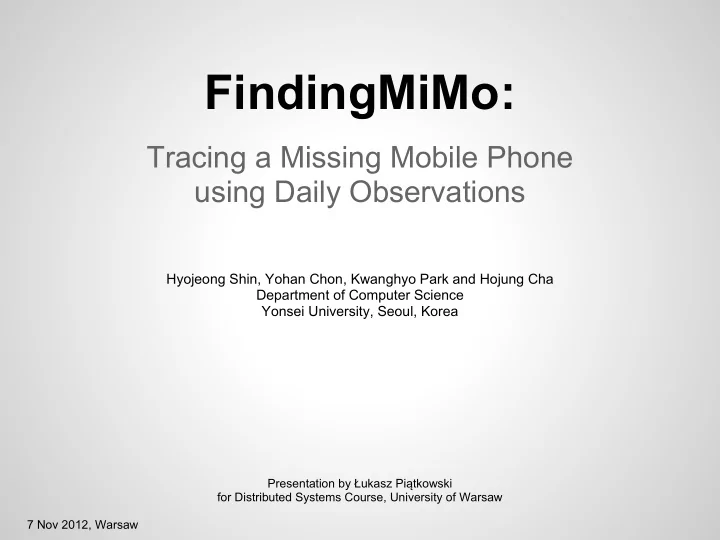

FindingMiMo: Tracing a Missing Mobile Phone using Daily Observations Hyojeong Shin, Yohan Chon, Kwanghyo Park and Hojung Cha Department of Computer Science Yonsei University, Seoul, Korea Presentation by Łukasz Piątkowski for Distributed Systems Course, University of Warsaw 7 Nov 2012, Warsaw
Mobile devices ● expensive ● small ● carrying private data ● energy-dependent
If you lose your mobile device ● you need to buy another one ● somebody can get your private data ● somebody can use your phone number ● you disrupt your daily communications ● your day is wasted
Introducing FindingMiMo 1. Outline of the problem 2. Related work 3. Solution 4. Implementation 5. Advantages 6. Disadvantages
Outline of the problem ● the user has lost his mobile phone in indoor environment with wireless LAN network ● the phone is switched on and there is an application preinstalled on it ● the user has access to another mobile phone
Outline of the problem ● the user has lost his mobile phone in indoor environment with wireless LAN network ○ floor plans, GPS signals, pre-learned radio maps, and non-standard hardware are usually not available ○ the building might have multiple aboveground and underground floors
Outline of the problem ● the phone is switched on and there is an application preinstalled on it ○ the application that monitors the device must be working in order to send data to another device ○ if the phone runs out of battery after being lost there should be a possibility to find it ○ the phone has access to the internet
Outline of the problem ● the user has access to another mobile phone ○ the device can be easily recharged ○ the device has access to the internet ○ the user can install an application on it
Related work ● "find a lost phone" services in Windows Mobile by Microsoft and MobileMe by Apple ● SensLoc and iLoc ● SoundSense, SurroundSense and Jigsaw ● UbiSense
Related work ● "find a lost phone" services in Windows Mobile by Microsoft and MobileMe by Apple ○ displays the approximate location of the remote device on a map ○ sets a pass code lock for wiping out the storage remotely for security reasons ○ uses GPS, cell-tower-based estimation and Wi-Fi fingerprints ○ accurate but insufficient in indoor
Related work ● SensLoc and iLoc ○ use GSM and Wi-Fi ○ detect movement, the entrance and departure time of meaningful places
Related work ● SoundSense, SurroundSense and Jigsaw ○ uses Wi-Fi, accelerometers, microphones, and cameras to generate an ambient fingerprint of places
Related work ● UbiSense ○ support precise real-time position referencing, long lifetime, and customized applications ○ deploys Ultra Wide-Band (UWB) antennas in a building and receives periodically emitted signals from mobile UWB tags ○ accurate and energy efficient ○ building has to have special infrastructure
Solution ● use case ● missing mobile application ● chasing mobile application ● results
Solution ● use case ○ mobile device collects daily ambient observations and logs them ○ chaser device remotely receives the log from the lost phone ○ the chaser traces the device by determining the places where the log is taken
Solution ● missing mobile application ○ LifeMap ■ continuously monitors a user’s physical location using GPS ■ writes down ambient fingerprint from GSM and Wi-Fi ■ uses activity-based sensor selection
Solution ● missing mobile application ○ MissingMobile ■ collects information from LifeMap on the path from the last known place to an unknown location ■ transmits the stored information to the chasing device ■ causes the missing mobile to make a loud sound after manual request from the chaser device
Solution ● chasing mobile application ○ SmartSLAM ■ traces pedestrian movement in indoor environments and simultaneously constructs an indoor floor plan ■ employs an accelerometer and a magnetometer in smartphone device to estimate the user’s walking path
Solution ● chasing mobile application ○ Chaser ■ measures the Wi-Fi conditions and compares them with the observations in the log ■ shows progress bar and "warm/cold" indicator
Solution ● missing mobile application ● chasing mobile application
Solution ● use case
Solution ● results ○ typical users spend approximately 13% to 20% of their time outdoors ○ the Wi-Fi logger may reduce the battery’s lifetime by 14% in average ○ the average amount of data for a day is 4.5MB to 22.3MB but the typical storage usage is around 5MB ○ the average approach distance is 4 meters
Solution ● results
Implementation ● Tanimoto coefficient function to evaluate the similarity between two input vectors ● GPS is activated for 30 seconds every 2 minutes outdoor ● stores Wi-Fi vectors every 5 seconds in moving state ● ... and for 30 seconds scans the surrounding APs every 10 seconds in stationary state ● the sampling interval is set at 2 minutes ● the similarity threshold of the Wi-Fi vector is set at 0.7
Advantages ● energy efficient ● accurate ● no need for special infrastructure ● even better results when using asymmetry multicore processor (AMP) technology ● sends information to server in case of discharging ● can be used to find child or pet
Disadvantages ● Wi-Fi infrastructure dependent ● requirements for chasing device ● misleading GPS readings ● misleading Wi-Fi signal from open space
The end
Recommend
More recommend